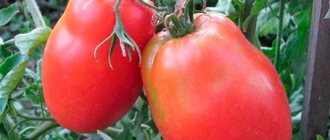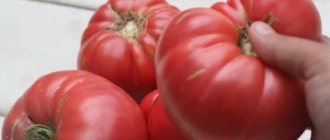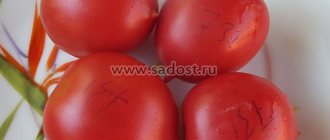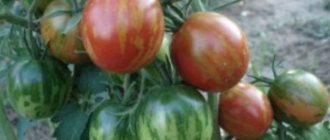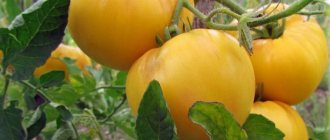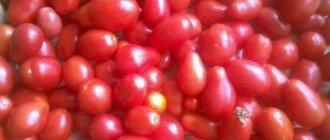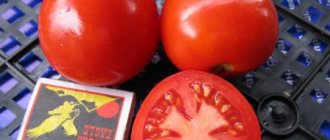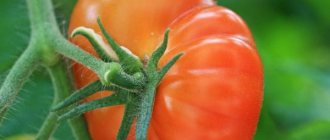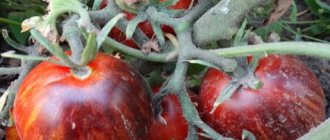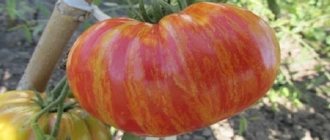Today, cherry tomatoes are widely used. Tomato Butterfly belongs to similar varieties. Suitable for growing in greenhouse conditions, under film cover and even on a loggia.
| Height | Landing location | Ripening time | Fruit color | Fruit size | Origin | Fruit shape |
| Tall | Greenhouse | Mid-season | Pink | Small | Variety | Plum-shaped or oval |
How to grow seedlings
According to the description on the package, the seeds are sown from April 1 to April 15. If landing is planned at the end of May or beginning of June, the dates are shifted to April 15-30.
Seed preparation
To protect the plant from fungal diseases and increase the percentage of germination, the seeds are treated with a solution of potassium permanganate and water before sowing (1 g of manganese is diluted in 100 ml of water at room temperature).
The result should be a dark liquid with a thick consistency - the key to high-quality disinfection. The seeds are placed in it for 25 minutes. If the packaging indicates that the material has already been processed, this step can be skipped.
Next, the planting material is washed with running water and dried with a paper towel. You can use a growth stimulator. A piece of gauze is moistened in the solution, the seeds are placed in it, placed in a plate or other container and left warm for 24 hours. The following products are suitable for this: “Epin”, “Kornevin”, “Silk”, “Zircon” or sodium humate.
Container and soil
It is recommended to plant seedlings in special containers, which are purchased at agricultural markets or in stores where seeds are sold. You can also make them yourself. The container should be wide, but shallow. Plant seedlings into pots whose volume does not exceed 300 ml. The photo below shows suitable containers.
Soil for seeds is made from humus and black soil. To make the composition softer, it is recommended to add additional sand, sawdust, and fine coconut fiber. Additionally, you can include ash and Fitosporin in the composition. If you plan to buy a ready-made mixture, it is better to choose one adapted for tomatoes and peppers.
The soil from the street, even though it is in a covered place, can contain many pests. To get rid of them, disinfection is carried out. To do this, the soil is calcined in the oven, poured with boiling water or doused with an aqueous solution of potassium permanganate. It is enough to wait 30 minutes.
Sowing
After preparing the soil, make holes or grooves in it no more than 1-2 cm deep at a distance of 2 cm from each other. The seeds are placed in the resulting depressions. They are sprinkled with earth on top, but not compacted. It is recommended to moisten the soil with warm water using a spray bottle.
To speed up germination, containers are covered with film or glass. Be sure to place the seedlings in a warm room. Optimal temperature control is within 23-25°C. In such conditions, the seeds will begin to germinate after 3-5 days.
Growing and care
After the first shoots appear, make sure that the temperature during the day is 16-18°C, and at night – no more than 13-15°C. The seedlings remain in this mode until 2-3 true leaves appear (after about 30-35 days). During the entire period, seedlings should be watered 2-3 times so that they do not stretch out during the low light season.
Every day, turn the container with seeds the other side towards the window so that the stems do not tilt. It is not recommended to water seedlings frequently. Make sure that water does not get on the foliage. The seeds are in the boxes without fertilizer. After 2-3 true leaves appear, the seedlings are planted in pots measuring 8x8 cm and left for about 20-25 more.
How is the soil prepared?
Before preparing the bed, the ground must be treated with a solution of copper sulfate at the rate of 1.5 liters per 10 liters of water.
The place for the bed where the Flag tomato will grow should be located on the sunny side, away from strong winds. Tomatoes are not grown in areas where groundwater approaches the surface. The best predecessors for culture are:
- beans and legumes;
- carrots and beets;
- greens and herbs.
Seedlings of early varieties are sent to the garden bed when they are at least 20 cm high and have 7 leaves. In Russia this is done starting May 15. Three bushes are placed per square meter, leaving 50 cm between rows.
Holes for tomatoes are dug using the bayonet of a shovel and watered. The root of the seedling along with the soil is deepened into the ground, covered with soil, compost, and compacted well. The bed is covered with film for several days. When the tomato bushes take root, the stem is hilled up to 12 centimeters, which improves root development and enriches the soil with oxygen.
Tomato Butterfly: description and characteristics of the variety, opinion of summer residents with photos
Currently, cherry tomatoes are popular among gardeners; among similar ones there is the Butterfly tomato. The description is very similar to cherry fruits, but this tomato is tall and produces a higher yield. Let's consider the qualities of Butterfly and the responses of those people who have already grown these tomatoes.
Varietal characteristics
The tomato bush is tall, mid-season and high-yielding. Determinate - grows up to 1.5 meters in height. The plant is powerful, heavily leafy; during the entire period, 3 clusters with a large number of fruits are formed on the bush. Up to 50 egg-shaped tomatoes will ripen on one branch. To get a higher yield, gardeners grow the plant in two trunks, with 3 clusters of fruit appearing on each. Thus, the yield from one plant is doubled. The yield reaches 5 kilograms if there are two branches, and accordingly the yield will increase. The ripening period from seed germination to harvest is 110–120 days. Recommended for cultivation in greenhouses and greenhouses.
When growing, the bush is tied to a support; the branches should also be fixed, otherwise they will break off under the weight of the tomatoes.
The fruits are egg-shaped and pink-raspberry in color; one fruit weighs on average 30–40 grams. They are all the same shape and size, so they look very nice in jars after seaming. The taste of the variety is good, sweet, the flesh is fleshy, the skin is thin. The fruits are suitable for processing, pickling and eating raw.
Positive traits
Judging by the reviews, the Butterfly variety has no bad qualities, only positive characteristics:
- High yield.
- High quality fruits.
- Marketable condition.
- Possibility to grow in two stems.
- Excellent taste.
- Versatility of use.
- Possibility of growing on a loggia.
Agrotechnics of cultivation
Butterfly is grown by seedlings; 60 days before planting in the ground, the seeds are planted for seedlings. Garden soil with black soil is used. The seeds are planted one centimeter deep, watered with warm water and covered with film until germination. When the sprouts hatch, remove the film and continue growing the seedlings in a well-lit place.
Tomatoes are planted in the place where parsley, dill, garlic, cucumbers or carrots used to grow. Planting pattern 50 by 40 centimeters. After planting the plants in the ground, they are cared for, which includes watering, weeding, loosening the soil, tying up and fertilizing the plants.
Characteristics of the Polonaise tomato variety and its description Read
Review of reviews about the variety
Let's consider the reviews left about the Butterfly tomato by gardeners who grew the variety.
Anna: “I planted this variety for the first time two years ago. The fruits are larger than cherry ones, sweet, tasty, liked fresh and pickled. The variety is distinguished by a large brush, on which up to 50 tomatoes ripen at the same time. At the end of summer I pinch off the top so that the fruits have time to ripen.”
Natalya: “I’ve been growing butterfly for two years now. Very tall, I tried to grow it with one trunk and with two, in any case, 3 clusters have time to ripen, so it is better to grow the variety on several trunks, the harvest will be twice as large. The tomatoes are small - up to 30 grams each, tasty, fleshy, pink in color. Next year I’ll leave room again for a couple of tomato bushes. I really like them!”
Advantages and disadvantages, features, differences from other varieties
Tomato Eagle beak
Large, fast, productive
A wonderful variety in all respects. Created by the work of a team of famous Siberian breeders (V.N. Dederko, T.N. Postnikova, A.A. Yabrov). The variety has a state patent and has been listed in the register since 2005. Medium early in terms of ripening. The plant develops at a rapid pace: seedlings produce real leaves early and quickly grow ovaries.
Tomato Southern tan
The sweetest
The patented original variety of Dederko and Postnikova has been registered in the state register since 2007. Similar to the Golden Koenigsberg (of the same authors), which does not have a patent and is not included in the register. The powerful bush of the plant requires obligatory pinching. The harvest is high, 7.7 kg per bush was collected. Tomatoes are oval with a spout, smooth, weighing 150-170 g;
Sugary raspberry
Mid-season tomato with high adaptive abilities. Tolerant to diseases and temperature changes. But with sharp fluctuations in humidity and excess dampness in the soil, it can burst. However, on the other hand, regular watering is necessary. Responsive to any feeding. The fruits are an appetizing dark crimson color.
The watermelon pulp is sugary. The weight of tomatoes is from 290 to 560 grams and even more. The variety of these vegetables was included in the register in 2007. The bush is about 1.5 meters high, the leaves are large, dark green. The inflorescence is simple. It requires tying the plant to a support and pinching. The best results were obtained when forming a bush with 2 stems. The second trunk is the stepson, located below the first flower cluster. The remaining side shoots must be removed
READ MORE: Clematis hegley hybrid photo description of variety reviews planting and care
Tomato Honey saved
Unpretentious and sweet
A flexible Siberian variety, easily adaptable to temperature changes: from high to low and vice versa. Tested and reliable. Ripening period is average, purpose: processing is encouraged, it better accentuates the taste in salads. In closed ground it can produce up to 5 kg. from one bush. Tomatoes are classic heart-shaped, smooth, beautiful.
When fully ripe they turn a deep orange color. Most of the crop ripens well on the vine, the rest of the fruits ripen well. They are characterized by excellent transportability and shelf-life. The weight of the fruit in the lower clusters reaches 420-530 g, closer to the top - 150-200 g. The pulp is tasty, sweet, and medicinal. Registered in the state register since 2005.
Tomato Pink Elephant
Sugary pink
In terms of ripening time, this popular variety is classified as mid-early. Included in the state register in 1998. Recommended for growing under film covers in all regions of the Russian Federation. The variety is not intended for industrial cultivation, but is appreciated by owners of small garden plots. The foliage is almost similar to potato tops.
Tomato Persimmon
Carotene piggy bank
In 1999, a variety created at the Moscow Timiryazev Academy based on varieties of folk selection type was entered into the state register. An interesting hybrid that combines many qualities: external beauty, taste and productivity. Medium-early in terms of timing (110-115 days), with prolonged fruiting.
The bushes are not too spreading, with dense large foliage. The first inflorescence emerges above the 7th leaf. There are from 3 to 4 tomatoes in a bunch - round, slightly ribbed, deep orange, weighing 230-360 g. The pulp is juicy. The taste has an aromatic sourness. The main value of the variety is the highest content of carotenoid vitamins. Vegetable yields are moderate.
Tomato Bull's forehead
Large and unpretentious
The variety adapts perfectly to greenhouse heat and street cold. Brings a decent harvest even when the year is unfavorable for growing - up to two buckets from 1 square. Tomatoes are round, slightly flattened, ribbed. Weight 0.5 kg or more. The pulp is dense. The ripening period is average; In open ground, about half of the fruits ripen.
Folk selection
Registered in the state register in 2001. An old variety of folk selection, packaged by different companies. Mid-season salad tomato. Tomatoes are round, flattened, moderately ribbed, sunny orange in color. They are meaty and sweet. There are 2-3 fruits in 1 kg. Record weight 700 g.
It has a rare quality for a meaty variety - it is resistant to cracking. From 1 square meter you can collect up to 1.5 buckets of fruit. Orange tomatoes contain much more beta-carotene than other groups of varieties of different colors. Therefore, these tomatoes are extremely popular among gardeners. The Orange Giant tomato is famous for its high yield and excellent taste.
Tomato Bugai red
Heavyweight
The newest variety (in the register since 2014) with self-limiting growth to 1.5 m. Ripening period - mid-early, with a long fruiting period. Large, flat, round tomatoes with an intense pink color ripen on the bush. The weight of the fruit reaches 600 g. Tomatoes have dense pulp, sugary at the break; the chambers contain a small amount of seeds.
Tomato Nonna M
Cordate
The newest mid-early variation of the Bull's Heart in the Siberian format. The raspberry-pink fruits are at once large, elegantly beautiful, and have a sugary taste and twist. Medium-early, from germination to the beginning of ripening 110-115 days. The plant is strong, 1.2-1.8 m high, depending on growing conditions. The fruits are elongated, heart-shaped, raspberry-pink, with a moiré tint, weighing 400-700 g.
Tomato Superbomb
The promise of record harvests
The mid-season new product promises a decent yield in open ground. The innovative Superbomb tomato is successfully grown in various regions of the country. It is not afraid of intense heat, scorching sun, and dry air. Fruit set remains consistently at a high level. The Superbomb tomato needs increased nutrition and moderate pruning. There are 5-6 tomatoes in a bunch, weighing 300-600 g. They are fleshy, rounded and flattened. The plant is compact, with self-limiting growth.
Tomato Puzata Khata
Unique shape
An original new variety from agro, on the state register since 2013. For lovers of unusual tomatoes. The variety is early (105 days is not uncommon), with extended yield and a total yield of 9.6 kg per 1 square. Tomatoes have an interesting pear shape with pronounced ribs. Fruit weight 185-270 g. Purpose: salad.
The Puzata Khata tomato variety is easy to care for; large, sugary fruits have excellent taste and good keeping quality.
No acid
The variety was registered in the state register in 2015 under the name Frog Princess. The bushes are powerful, the leaves are medium sized. The ripening period is mid-early or mid-ripening (112-123 days). Fruit weight 235-280 g. They are flat-round, slightly ribbed, light green with the lower part turning yellow when ripe.
When fully ripe, the vegetables are golden-greenish, with a slight bronze tint. The pulp is juicy, dietary taste with low acidity. The yield from 1 plant in open ground reaches 5.6 kg per square; in a greenhouse - a maximum of one and a half times higher. The purpose is salad. The green color of ripe tomatoes is due to the fact that tomatoes have a high chlorophyll content.
Advantages of the variety:
- early ripening;
- stable yield, independent of weather conditions;
- good taste;
- relatively good resistance to diseases;
- long-term fruiting.
No significant deficiencies were identified. You can find other high-yielding and disease-resistant varieties here.
You can see the yield of other varieties in the table:
- Tomatoes planted directly into the soil have a stronger and more developed root system, more foliage and a thick stem.
- Adaptation to sunlight and climatic conditions occurs immediately.
- Plants develop strong immunity and endurance.
- The tomato will not suffer from transplanting from a pot to a garden bed.
Speaking about the benefits, we must not forget about the risks, and they always exist:
- Germination is slightly worse; more seed is needed.
- Danger of weather vagaries in the form of heavy rains and frosts in spring.
- The harvest is 2-3 weeks later than with seedlings.
Growing seedlings
Growing a Summer resident tomato is practically no different from cultivating other universal varieties. This is an early variety, and therefore seed planting begins in mid-February; seedlings are transferred to open ground in early May.
Planting seeds
Before planting, the seeds must be disinfected using a weak solution of potassium permanganate.
When sowing seeds in open ground or after planting seedlings, the soil must be treated with biofungicides. Although this early tomato is highly resistant to various diseases and parasites, prevention will not be superfluous.
Serum with iodine is also used as preventive measures. The spraying solution is prepared according to the following scheme: for 1 bucket of water, take 2 cups of whey and 2 tsp. Yoda.
Sprout care
Seedlings need regular watering. You cannot overwater the plant.
Before being placed in open ground, the sprouts need to be hardened.
To carry out hardening, use one of the following methods:
- Place the seedlings outside the window for several hours.
- Place the container with the sprouts in the refrigerator.
- Point a fan at the sprouts.
- Leave a window open next to the seedlings.
Seedlings require mandatory hardening
All this will help strengthen the seedlings and increase the plant’s immunity.
Transplanting
Since the bushes of this tomato are small, 1 square. m can fit from 6 to 8 plants.
The root system of the plant is not very large, and therefore shallow holes are suitable for planting. The distance between bushes should not exceed 20 cm.
After planting in the ground, the seedlings are insulated with mulch, and the soil must be watered abundantly.
Fertilizer
Fertilizer application takes place according to a certain scheme:
- The first fertilizing is done during planting of seedlings. Mullein and nitroammofoska with a few grams of boric acid are best suited.
- The second feeding is carried out 3 weeks after planting the seedlings. The composition is the same, only potassium sulfate is used instead of boric acid.
- Then fertilizers are applied every 2 weeks until flowers form on the tomato. Rotted manure is used as fertilizer.
Boric acid is used as an auxiliary agent, which is sprinkled on both flowers and already formed fruits.
Watering
Since the Summer Resident tomato is unpretentious, it does not require careful care and abundant watering. But you shouldn’t forget about it for a long time. It is enough to water the tomatoes with warm water two or three times a week and then the variety will delight you with a bountiful harvest.
Tomatoes of the universal variety Summer Resident are the right choice for those who cannot devote a lot of time to caring for the garden. So this type of nightshade is not afraid of droughts or pests.
Description of the exotic tomato Blue P20, cultivation and care
Not everyone likes the exotic tomato Blue P20. Gardeners are sometimes dissatisfied with its taste and grow it only for its beautiful and unusually colored fruits. But the variety also has its advantages.
General characteristics of the plant
The bush is indeterminate, in open ground it manages to reach a height of 1.6 m during the summer season, and in greenhouse conditions it can grow even higher. The stems of the plant are powerful, but they still require support. Due to the tendency to branch, it is necessary to carry out pinching and form bushes into 2-3 trunks.
The Blue P20 tomato variety is a hybrid of the American Indigo rose variety, famous in Russia, and inherited not only its unusual color, but also high resistance to late blight. Reviews from gardeners in the Leningrad region and their Ukrainian colleagues note the absence of signs of the disease even in seasons with unfavorable weather conditions. The tomato does not suffer from Alternaria, Fusarium and other diseases of nightshade plants.
The American variety turned out to be adapted to Russian conditions. It tolerates sudden temperature changes in the summer, when the heat gives way to cold rains, is resistant to drying out of the soil and is not too demanding to care for.
Productivity is average. The Blue P20 variety was not created for the industrial production of vegetables, so it is difficult to expect the performance of modern industrial hybrids from it. But it is quite capable of providing the owner with early tomatoes for the table and decorating salads until late autumn. During the season, each bush can produce about 4 kg of tasty and beautiful medium-sized tomatoes.
Features of the fruit
The variety is early ripening. The fruiting period declared by the seed manufacturer () occurs 95-100 days from sowing the seeds. But in Russian conditions (in open ground), it will be possible to obtain the first tomatoes at technical ripeness only at the end of July, and standing tomatoes ripen in August. On 1 stem, 3-5 clusters are formed with fruits of the same size, round, non-ribbed shape. There can be 6-8 tomatoes on a brush, each weighing approximately 100 g.
The most unusual thing is the color of the fruit. The Blue P20 variety contains anthocyanins, which give its skin a blue tint. The part of the fruit adjacent to the stalk is colored. The violet-blue color is especially noticeable on the tomato at technical ripeness, but persists even after ripening. Tomatoes containing anthocyanins are beneficial for humans: the pigment suppresses the development of cancer cells and helps strengthen vascular walls.
The skin of Blue P20 tomatoes is dense, protects the fruit well from cracking, does not burst during heat treatment during canning and does not lose color when exposed to a hot solution of vinegar and salt. Tomatoes are well transported; in an unripe (blanzhevoye) form they can be stored at room conditions for 2-3 weeks, gradually reaching full ripeness.
The pulp is dense, but soft and juicy. The seed chambers are large and contain few grains. The walls of the fruit are thick, up to 1 cm. The pulp is uniformly dark red, very rich in color. When harvested at technical ripeness and artificially ripened, an uncolored area may remain near the stalk.
Taste qualities according to the manufacturer are high, the tomato is sweet, dessert taste. But some gardeners characterize Blue P20 tomatoes as mediocre in taste, with sharp sourness and relatively little sweetness. The discrepancy may be caused by different tomato growing conditions: with a lack of heat and sunlight, many sweet varieties lose some of their sugar content and become sour or tasteless.
The purpose of the Blue P20 variety is universal. Purple-red tomatoes look impressive in salads and slices, and can be used for gourmet snacks. Small portioned tomatoes with thick walls are convenient for stuffing salads when serving at a buffet table, and will beautifully complement a holiday slice or sandwich.
Purple fruits also look unusual when preserved. But the juice from these fruits will be the most ordinary, although it will have a darker shade. Tomatoes with a beautiful color can be used for drying; the shade of the skin will be fully preserved with this harvesting method.
Agricultural technology varieties
Growing Blue P20 tomatoes in central Russia is possible only through seedlings. This method allows you to get ripe tomatoes a little earlier if you sow the seeds 70-90 days before transplanting into the ground. When growing seedlings, the first flower clusters may appear indoors. Seeds can also be left from your own plants; the variety retains all maternal qualities.
Features of the hybrid Butterfly F1
The Summer Resident tomato is not young: it was registered in the State Register of the Russian Federation in 1999.
The variety was obtained by specialists from the All-Russian Research Institute of Vegetable Growing; the originator was, among other things, the seed industry. At that time, there was no such wave of new varieties and hybrids, and each new product could be tracked by amateur gardeners. The summer resident turned out to be a lifesaver for many enthusiasts, although it is officially approved for cultivation only in the North Caucasus region, of course, in open ground. Yes, it is not profitable to plant this tomato in a greenhouse: its bush is not tall, and a lot of free space will be wasted. But in those regions where tomatoes can grow without greenhouses, gardeners began to plant this variety with pleasure.
Brief description of the tomato variety Dachnik according to the State Register
The Dachnik variety is a representative of determinate tomatoes; its bushes rarely exceed the half-meter mark in height and practically do not require the formation or even tying of shoots. The bush is semi-spreading in shape, branching and foliage are at an average level. Leaves are of normal size and color. 4–5 fruits are formed in the cluster.
The summer resident’s bushes are small, but covered with fruits
In terms of ripening time, the variety is classified as an early ripening variety; the first fruits ripen approximately 100 days after germination. In the south, it is sometimes even considered ultra-early, although now there are many varieties that ripen a week or two earlier than Dachnik. The first wave of the harvest, lasting one and a half to two weeks, is the main one, then fruiting continues little by little until frost.
The fruits are medium-sized, round or flat-round in shape, scarlet or red in color, containing at least four seed nests. The weight is in the range of 50–100 g: tomatoes cannot be called leveled. The taste of fresh fruits is characterized as good, with a pronounced “tomato” aroma. The skin is thin, the pulp is medium dense. The main purpose is salad, but the size of the fruit allows them to be preserved as a whole.
Since at the time of its appearance the variety was recommended for commercial production, that is, for large agricultural enterprises, its tests were carried out not in small gardens, but in field conditions, where it showed good yield. In official documents it is given in terms of per hectare.
On average, the variety produces from 250 to 350 c/ha, which is at the level of standard commercial varieties. In the open ground, summer residents, with not very careful care, can harvest up to 4 kg of tomatoes per square meter. The possibility of industrial cultivation is based, among other things, on the good transportability of the crop. Fresh tomatoes can be stored for up to three weeks.
The variety is highly resistant to diseases, including fusarium and blossom end rot. Despite its regionalization in the south, it has good cold resistance. Since the bushes of this tomato are quite compact and stocky, it is often planted indoors, as well as on the balcony.
Like many other early-ripening, unpretentious tomatoes, Dachnik cannot boast of an exquisite taste. Something else is required of him: early and without much hassle, provide the owner with a good harvest of vitamin products. The main advantages of the variety are:
- early ripeness;
- simplicity of agricultural technology;
- stable yield;
- transportability of the crop;
- versatility of use;
- excellent fruit set, including in unfavorable conditions;
- Possibility of growing on the balcony.
Among the disadvantages is not the best taste of the fruit, the possibility of late blight. In addition, despite the determinacy, it is still advisable to tie up the bushes, although not all summer residents do this: under the weight of the harvest, they can lie on the ground, and the tomatoes simply get dirty or become prey for slugs.
Since the word “summer resident” is quite common, it is also found in the names of other varieties and hybrids of tomatoes, so do not confuse Summer Resident with the tomatoes Ural Summer Resident, Summer Resident of Kuban, as well as with the hybrid Summer Resident F1, the seeds of which are sold by the agricultural company Aelita: this hybrid produces a huge amount stepsons and needs to form a bush.
There are many analogues of the Dachnik variety, including among old varieties. It is quite similar to the famous Alpha and Betta tomatoes, but ripens a little later. The advantage of these varieties, compared to Dachanik, is the absence of regional restrictions, but they are not recommended for commercial production.
Tomato Alpha is similar to Dachanik in many respects, but ripens earlier
The Summer Resident tomato can be grown without preparing seedlings, especially in the recommended North Caucasus region. Seeds sown directly into the garden bed with the onset of warm weather or under temporary shelter will sprout perfectly, and after the required 3.5 months it will be possible to harvest ripe tomatoes. But in regions that are not the warmest, this approach will allow you to harvest only in August, when you no longer really want tomatoes that don’t have the most exquisite taste. Therefore, in most areas, Dacha is grown through the seedling stage.
Seedlings of this tomato are easy to obtain; you should not sow the seeds too early. After all, seedlings can be planted in a garden bed only at the onset of summer, but for a summer resident they are ready for planting already at the age of one and a half months. By two months the bushes are already beginning to bloom. But the small growth of tomatoes makes it easier to install temporary shelters, which is often used to obtain an earlier harvest. Under this condition, in the middle zone, planting seedlings is possible as early as May 10–15, which means that seeds can be sown in boxes in mid-March.
No pots are required to grow Summer Resident seedlings: stocky plants grow well in a common box
The fruits of the Summer Resident tomato mostly have time to ripen on the bushes; there is no need to pick them unripe: this is done only in the fall, before frost, but by then only a few specimens remain in the beds.
Tomato Summer resident is a variety for busy gardeners. It does not require special care and reliably produces early harvests of quite good tomatoes.
Each tomato variety has its own personality. Behind each are years of work by breeders and decades of popular selection. The beauty of the best modern tomato varieties is their diversity. So we “exploit” tomato hybrids and varieties with unlimited growth - indeterminate, semi-determinate, and determinate, the average height of which for the most part ranges from 70-80 cm, and low-growing vegetables, whose height does not exceed half a meter (all of them We will discuss the differences and features in the article below).
READ MORE: Spearmint (garden): description of the variety, cultivation and care with photos
You cannot give advice based on outside experience, as some do, deliberately introducing not entirely truthful information about the yield (quantity and quality) of grown tomatoes. They say here they are - the best varieties of tomatoes of the past (and, further, in descending numbers) for tomatoes of the year. With everything, however, it should be noted that they often focus on plant varieties proposed for planting for open and closed ground, without understanding that the advice will be good only after personal experience - better after at least 3-4 years (honestly, but extremely rarely , and 2 are sometimes enough) and with meticulous experiments (starting with growing seedlings using the soil additive Vermiculite, the growth stimulator Gumi and, ending with fertilizing: magnesium sulfate, mineral fertilizer Fertika-Kemira and so on - already in the garden) for each variety.
Why am I giving such a deadline? Yes, because you definitely need to take into account the weather, which differs from year to year, and this is the minimum, in my opinion, period to have more or less an idea about each variety of tomatoes.
Before you accurately choose a variety or hybrid of tomatoes, you need to decide where exactly they will grow.
For open ground, low-growing varieties that will ripen early are more suitable. Mid-ripening species in good summer weather can produce a fairly good harvest, but they are susceptible to microflora, which can destroy most fruits.
It is customary to grow tall varieties and various hybrids in greenhouses. Here you can plant absolutely any tomatoes, even late-ripening ones.
These are tomatoes that will grow until they turn blue until the owner or the onset of the cold season stops them. They have great yield potential, which is more successfully realized in high greenhouses. We place approximately three bushes on 1 square. With supports such as strong trellises, open ground is not prohibited, which will be especially welcome in the southern regions.
Tomato Scarlet candles
Good for pickling, sweet. This is a patented mid-early variety (Siberian breeders distinguished themselves!). In the state register since 2007. They are characterized by a high ability to form ovaries in any conditions. From 1 sq.m you can actually get a bucket and a half. The clusters are arranged in tiers, the weight of the fruit on the lower branches reaches 120 g, on the top ones - half as much.
Very lightweight. A mid-early Siberian variety for canning whole vegetables. The fruits are elongated, reaching (maximum in our conditions) 13-14 cm in length, weighing about 120 g, and have a beautiful crimson hue. They have few seeds, are very fleshy, strong, and easy to keep. If they are picked green, they do not spoil and ripen perfectly. The variety is very responsive to high-quality fertilizing.
| Variety name | Summer resident |
| general description | An early-ripening, determinate variety of tomatoes for growing in greenhouses, greenhouses and open ground |
| Originator | Russia |
| Ripening period | 96-105 days |
| Form | Flat-round with slightly pronounced ribbing near the stalk |
| Color | Red |
| Average weight of tomatoes | 55-110 grams |
| Application | Recommended for consumption fresh, in the form of purees, salads, juice, has proven to work well in canning |
| Productivity of the variety | 3.8-4.2 kilograms per bush |
| Features of cultivation | Standard agricultural technology |
| Disease resistance | resistant to blossom end rot and fusarium |
Tomato Butterfly: description and characteristics of the variety, opinion of summer residents with photos
Currently, cherry tomatoes are popular among gardeners; among similar ones there is the Butterfly tomato. The description is very similar to cherry fruits, but this tomato is tall and produces a higher yield. Let's consider the qualities of Butterfly and the responses of those people who have already grown these tomatoes.
Varietal characteristics
The tomato bush is tall, mid-season and high-yielding. Determinate - grows up to 1.5 meters in height. The plant is powerful, heavily leafy; during the entire period, 3 clusters with a large number of fruits are formed on the bush. Up to 50 egg-shaped tomatoes will ripen on one branch. To get a higher yield, gardeners grow the plant in two trunks, with 3 clusters of fruit appearing on each. Thus, the yield from one plant is doubled. The yield reaches 5 kilograms if there are two branches, and accordingly the yield will increase. The ripening period from seed germination to harvest is 110–120 days. Recommended for cultivation in greenhouses and greenhouses.
When growing, the bush is tied to a support; the branches should also be fixed, otherwise they will break off under the weight of the tomatoes.
The fruits are egg-shaped and pink-raspberry in color; one fruit weighs on average 30–40 grams. They are all the same shape and size, so they look very nice in jars after seaming. The taste of the variety is good, sweet, the flesh is fleshy, the skin is thin. The fruits are suitable for processing, pickling and eating raw.
Positive traits
Judging by the reviews, the Butterfly variety has no bad qualities, only positive characteristics:
- High yield.
- High quality fruits.
- Marketable condition.
- Possibility to grow in two stems.
- Excellent taste.
- Versatility of use.
- Possibility of growing on a loggia.
Agrotechnics of cultivation
Butterfly is grown by seedlings; 60 days before planting in the ground, the seeds are planted for seedlings. Garden soil with black soil is used. The seeds are planted one centimeter deep, watered with warm water and covered with film until germination. When the sprouts hatch, remove the film and continue growing the seedlings in a well-lit place.
Tomatoes are planted in the place where parsley, dill, garlic, cucumbers or carrots used to grow. Planting pattern 50 by 40 centimeters. After planting the plants in the ground, they are cared for, which includes watering, weeding, loosening the soil, tying up and fertilizing the plants.
Review of reviews about the variety
Let's consider the reviews left about the Butterfly tomato by gardeners who grew the variety.
Anna: “I planted this variety for the first time two years ago. The fruits are larger than cherry ones, sweet, tasty, liked fresh and pickled. The variety is distinguished by a large brush, on which up to 50 tomatoes ripen at the same time. At the end of summer I pinch off the top so that the fruits have time to ripen.”
Natalya: “I’ve been growing butterfly for two years now. Very tall, I tried to grow it with one trunk and with two, in any case, 3 clusters have time to ripen, so it is better to grow the variety on several trunks, the harvest will be twice as large. The tomatoes are small - up to 30 grams each, tasty, fleshy, pink in color. Next year I’ll leave room again for a couple of tomato bushes. I really like them!”
The best varieties of tomatoes for 2021: photos and descriptions
When choosing tomatoes for their plot, gardeners, first of all, rely on varietal or hybrid characteristics. Productivity is the most important criterion on which the quantity and quality of the harvest depends. Sometimes it can be difficult to choose the right option from the rich variety of tomatoes for open ground and greenhouses. Then varieties are selected depending on the growing region, ripening period, degree of disease resistance and other factors.
Varieties for open ground
A huge number of species with excellent yields are intended for growing vegetables in the open air. Low-growing bushes with large fruits are one of the advantages of tomatoes for the soil. Such heat-loving plants are easier to care for and do not require complex agricultural practices.
According to ripening period
Tomatoes, like other vegetable crops, are characterized by different ripening periods, from early to late.
| Ripening period | Ripening of fruits after the appearance of the first shoots | general characteristics | The most productive tomatoes (2020) |
| Ultra-early ripening | On day 80-85 | The fruits are small, juicy, and low in sugar. The height of the bush is no more than 50 cm. Not suitable for preservation. | Little Red Riding Hood, Pride of Russia, Benito, Superstar, Valentina, Marisha, Maksimka |
| Early ripening | For 90-95 days | Small, delicate fruits, average yield. Suitable for canning and salads. Bushes grow up to 70 cm | Agatha, Riddle, Augustine, Lyana, Sanka, Buyan, Lakomka, Amur standard, Grandmother's kiss |
| Mid-early | On days 100-103 | The fruits are juicy, small, aromatic. The purpose is universal. Bush shape - compact | Openwork, Babushkino, Pulka, Red Giant, Russian Soul, Cardinal, Flamingo |
| Mid-season | On day 100-115 | High taste, excellent yield. There are both low-growing and tall varieties | Scarlet Candles, Hybrid Basket, Stresa, Intuition, Black Baron, Pudovik, Pink Honey |
| Late ripening | On day 120-130 | Excellent fruit taste, high yield, universal purpose. Good keeping quality and transportability of fruits | Giraffe, Cosmonaut Volkov, Titan, Rio Grande, Russian size, King of Kings, Rocket, Premier |
The ripening time, color and shape of tomatoes depends on the variety.
Usually early-ripening vegetables with not large fruits and not a large harvest, but with a quick, friendly yield of ripe tomatoes. Mid-season ones also have medium sizes. Late ones are usually difficult to care for, but it is among them that you can find champions in weight, but there are not many such beauties on the bush.
By growing region
Every year, breeders create new species with high quality indicators. In stores you can buy specialized varieties of tomatoes designed for growing in certain climatic conditions. Classification by regions of Russia:
- for the Moscow region: Champion, Sweet Bunch, Honey, Pink Elephant, Fireworks, Bull's forehead;
- for the southern regions: Torch, Novice, Titan, Winner, Bison, Ermak, Gift, Mikado;
- for the middle zone: Bull's Heart, Black Prince, Uzbek (Yusupov), Moskvichka, Snowdrop, Big Brother, Spasskaya Tower;
- for Siberia: Siberian heavyweight, Ultra early ripening, Sanka, Abakan pink;
- for the Urals: Coin, Bull's Heart, Button, Countryman, Yellow Buyan, Bullfinch, Demidov;
- for the far north: Snowy Tale, Ballerina, Ladyfingers, Berdsky Large, Countryman, Oak, Gina.
An unpredictable, cold or, conversely, excessively warm climate is not a reason to refuse to grow tomatoes in open ground. Thanks to selection, varieties have been developed that grow and develop well in any terrain.
According to disease resistance
To obtain a rich harvest, you need to choose tomato varieties not only with the appropriate characteristics. It is necessary that this criterion be supplemented by such an indicator as disease resistance.
Late blight, root rot, tobacco mosaic, cladosporiosis are diseases that most often affect plantings of heat-loving crops.
A catalog of tomatoes that can withstand the onslaught of various diseases:
- Blitz;
- Koenigsberg;
- Geisha;
- Betta,
- Anyuta;
- Bohemia;
- Chio-chio-san;
- Tatiana;
- Puzata hut;
- Lights of Moscow;
- Yablonka Russia;
- Crimson giant.
Unfortunately, there are no varieties that are 100% resistant to infections. But there are hybrids that produce a harvest until the active phase of many fungal diseases and infections begins.
Varieties for greenhouse cultivation
Having a good greenhouse at your disposal, you can get fresh tomatoes to your table all year round. Greenhouse varieties are suitable for preparing salads or canning. Excellent salad tomatoes can be obtained from the following varieties:
- Geisha;
- Fairy gift;
- Andromeda;
- Eagle beak;
- Pink Angel;
- Pink Pearl;
- Fatalist;
- Scarlet caravel;
- Amana orange
The best varieties for preservation:
- Auria;
- Banana legs;
- Pink raisins;
- Rajah;
- Baba;
- Alexander the Great.
Cherries are sweet, small tomatoes that grow well both outdoors and in a greenhouse, but small-fruited vegetables tend to be more productive in protected beds. Magic Harp F1 and Yellow Caramel F1 are hybrids whose fruit weight does not exceed 25 g.
When choosing a vegetable for a greenhouse, many rightly give preference to tall and high-yielding varieties. But low-growing plants, which usually have an early ripening period, as well as mid-ripening tomatoes, are also excellent for polycarbonate shelters in all regions of Russia.
Description and photos of the best hybrids
For open ground, breeders also offer species with high yields of hybrid origin; they are resistant to diseases and temperature changes. The best tomato varieties of 2020:
- Intuition F1 is one of the best tomato hybrids for picking with trusses, mid-season, from germination to harvesting the first vegetables - 110 days.
- Katya F1 is an early ripening hybrid. The fruits weigh 90-130 g and ripen simultaneously. From 1 m² you can harvest more than 10 kg of fruit per season.
- Search F1 – unpretentious and at the same time tasty tomatoes. The hybrid withstands cold weather and is immune to most diseases. The bushes are strewn with small red fruits, which are excellent for pickling and canning.
- Blagovest F1 is an early-ripening hybrid. The fruits are round, glossy, with slightly pronounced ribbing. From one bush you can collect up to 5 kg of fruit.
- La la fa F1 - has excellent consumer qualities, high yield and unpretentiousness. The average weight of the fruit is 140-170 g. From 1 m² you can harvest up to 20 kg.
- Vladimir F1 - has a high yield and is suitable for cultivation in any type of soil. High productivity throughout the entire fruiting period.
- Beef King F1 is an early maturing Dutch hybrid. The tomatoes are round, dense, smooth. From one bush you can collect up to 4-5 kg. Resistant to low temperatures and diseases.
- Ashdod F1 – tomatoes with smooth, dense skin. Fruit weight is from 110 to 140 g. The pulp has a bright burgundy color.
- Tanya F1 is a hybrid from the Netherlands with excellent immunity, dense structure, and good yield. The fruits have a regular round shape, weighing 150-200 g. They tolerate transportation well.
If the designation on a bag of planting material is F1 – hybrids of tomatoes (or other plants) of the first generation, F2 – of the second, and so on.
Exceptional taste, fruit weight, constant yield, disease resistance, adaptation to weather conditions are the advantages of hybrids over tomato varieties.
Reviews
Varvara Petrovna, 56 years old:
My favorite tomato variety in 2021 is Idol, medium-sized, very tasty, productive. I planted seedlings on March 20, the first fruit was picked on June 20. The bushes bear fruit for 3 months. The most successful cherry variety is Black Cherry, very tasty and productive, the most favorite tomato of children.
I like the fruits to be large and regular in shape. Therefore, I prefer the varieties Early Rose, Peach, Heavyweight of Siberia and Pink Fig. This year I raised Grandma's Secret. The bush is determinate, the average height is 180 cm. I have never produced kilogram fruits, the maximum weight is 700-800 g. Probably this is because I allow the bush to form into two or three stems.
I never conduct systematic analysis. I analyze when the tomatoes are already picked. I love large, sugary berries. I really like the Pink Giant in taste, but the yield is low. So far, my requirements are relatively met by 2 varieties - Pink Andromeda and Mazarin. Over time (I’m a novice gardener) I’m thinking of finding the optimal variety or hybrid of tomatoes.
Diseases
The described tomato variety is characterized by high immunity to fusarium, late blight and blossom end rot. This is an early cold-resistant variety, and therefore the fruits ripen quickly - the plant does not have time to get sick.
The plant also has high immunity to various insects, so insecticidal preparations are rarely used.
Prevention
It is not for nothing that gardeners choose Dacha tomatoes, because they do not require the preventive application of insecticidal preparations.
Tomato Summer resident (The best varieties of tomatoes)
Summer resident
Variety – “SUMMER RESIDENT”. Tomatoes from Fyodor.
The hybrid often suffers from whitefly attacks.
Description of the Pablo tomato variety, yield and cultivation
Tomato lovers will appreciate the fruit of modern selection - the Pablo f1 tomato. Numerous advantages have ensured that the variety is in demand among gardeners in different regions of Russia. The originator of the plant was the Japanese company Sakata, and today the new product was officially entered into the state register.
General information about tomato
The Pablo variety of tomato is suitable for growing in greenhouses and open beds. Description of the appearance and characteristics of the plant:
- early ripening, the period before harvest is 95 days;
- indeterminate, has unlimited growth;
- tall, reaches 2 meters;
- powerful root system;
- good foliage;
- slightly ribbed;
- average yield, over the summer they get up to 4 kg per 1 sq. meters of landing;
- the number of fruits in the cluster is 5-6 pieces;
- good adaptive abilities;
- ease of care;
- resistance to most diseases of the nightshade family;
- possibility of transportation over long distances without loss of presentation;
- keeping quality.
Tomatoes have become a novelty among hybrid varieties. The ability to bear fruit in unfavorable weather conditions and poor soils has made it possible to grow tomatoes in all regions of Russia. Technical data and appearance of the fruit:
- flat-round, leveled shape;
- dense;
- thin skin;
- large, average weight 200 grams;
- red color when ripe;
- sweet taste;
- fleshy, not watery;
- fragrant.
Recommendations for cultivation
The plant prefers the seedling method of planting. Preparatory work begins 2 months before the expected planting date. When preparing seedlings, it is recommended:
- sow seeds to a depth of 1-1.5 cm;
- after planting, cover the containers with film;
- maintain temperature 21-25 degrees;
- after the sprouts appear, remove the film, transplant the tomatoes into separate pots and move them to the light;
- regular watering;
- picking.
IMPORTANT! Before planting, seedlings should be hardened off. For 1 sq.
Place no more than four tomatoes per meter of land according to a 40 x 60 cm pattern. The plant is undemanding; mandatory care measures include:
For 1 sq. Place no more than four tomatoes per meter of land according to a 40 x 60 cm pattern. The plant is undemanding; mandatory care measures include:
- watering with water not lower than the air temperature;
- feeding with complex mineral fertilizer, at least 4 times during the summer period;
- regular loosening and weeding of the soil;
- pinching, forming a bush into one stem;
- installation of supports and tying to the trellis with synthetic materials.
Gardeners' opinion
Good afternoon. I've heard positive reviews about Pablo's tomato. This summer I tried to grow it and was pleased.
The tomato bore fruit in the cold summer, withstood all unfavorable conditions, and had good yields. Suitable for cultivation in the northern regions of Russia. There were no difficulties in care. In greenhouse conditions I received 3 kilograms of berries from 1 sq. meters of landing. I recommend!
Valerian Egorovich, 54 years old.
Good afternoon! I recommend the Pablo variety to all tomato lovers. It tolerates heat well and does not require close attention. Suitable for growing in open ground in the southern regions of Russia. Ripe berries are suitable for salads, twists and pickles.
Advantages and disadvantages, features, differences from other varieties
Our technology for growing tomatoes of different varieties is as follows. On our plot we allocate 6 long rows for tomatoes (including closed soil). On three of them, representatives of the best varieties of tomatoes, proven over the years, are grown (there are also tomatoes to choose from), guaranteeing a harvest according to the declared characteristics (regardless of the “delights” of the weather), and the other three are planted with new varieties, which are “considered” this way and that in during the above time. That seems to be it.
PS To make life easier for readers and reduce the time it takes to absorb the article, instead of determining the yield of vegetables in kg per 1 square meter, it will be written below - kg “per square”.
And now I am announcing the number of tomatoes tested in growing, presented below for your viewing, which can still be called the best - 60 varieties.
PS The results were recorded in an area that: with a good warm season, corresponds to the Central Black Earth region (region), and with a bad warm season, corresponds to the North-Western region. Naturally, this range of latitudes in which the above regions are located definitely includes Siberia, the Moscow region, the Middle Zone, the Urals, the Far East, and then figure out for yourself where exactly the paths lead to your site.
Hybrid tomatoes are virtually guaranteed to be resistant to diseases and bad weather conditions, which is something that non-hybrid varieties suffer from. Greenhouses and greenhouses are valued for storing heat, but in them tomatoes can suffer from too high temperatures and sudden temperature changes. In recent years, world selection has been aimed at producing “heat-resistant” hybrids with a reliable guarantee of ovary production.
Hybrids are especially helpful in a greenhouse or a small garden plot where there are no real opportunities for crop rotation and diseases are prevalent. Selection successes demonstrate confident resistance to various types of infections - viral (especially the most dangerous tobacco mosaic virus), fungal, bacterial. In addition, the hybrids have uniform fruits and consistently high yields.
Tomato Incas F1
One of the best hybrids for canning whole fruits without skin. Popular early high-yielding bush hybrid. The plant is medium-sized, compact.
Tomato from the Dutch company Numens, zoned in Russia; entered into the state register in 2000. Mid-early hybrid (105 days) of meter-high vegetables, determinate. Very high resistance to fungal diseases has been recorded. The fruits are 80-100 g, dense, bright red, pepper-shaped, fleshy, uniform, tolerate sunburn well, are very easy to ripen, transported over long distances without loss of quality.
Tomato Torquay F1
Dutch hybrid from Bejo Zaden; in the Russian register since 2007. Mid-season tomato (119-123 days from germination to ripening), bush type - determinate, maximum height 100 cm. Forms abundant multiple clusters with fruits weighing 60-140 g. Dense tomatoes withstand long-term transportation, excellent in pickling and pickling matters.
Tomato Mariana F1
The tomato was created in the French branch of the Japanese company Sakata (the image of the woman Mariana is a symbol of the French Republic). The breeders of this agricultural company are often suspected of producing GMOs, but so far without real evidence. Mariana is a mid-early determinate hybrid. The fruits are similar in shape to Incas - also elongated-oval, perfectly smooth, super dense.
Tomato Bagheera F1
Hybrid from the leading French seed company Cloz. Included in the Russian seed register in 2007.
Early high-yielding hybrids are a real boon for the garden. They are cold-resistant, do not need pinching or tying up, and practically do not get sick. The ripening period is marked as medium-early; determinate bush. The fruit is round, flattened on top, ribbed, weight ranges from 80-220 g. The hybrid is resistant to soil drought and nematode, more suitable for regions located in the south. Does not suffer from fusarium and verticillium wilt.
Tomato F1 Semko 2005
The tomato is suitable for open ground and under film shelters (greenhouses). Determinate, medium-sized, compact. Resistant to soil salinity, drought, high temperatures, grows well in open ground in both southern and northern regions. Vegetables practically do not suffer from viral and fungal diseases, even late blight.
Tomato F1 Semko 2010
Included in the state register in 2010. Ultra-early ripening determinate hybrid - 85-88 days pass from the sprouting of green vegetables to the coloring of fruits. The first brush is formed immediately after the sixth leaf grows. The fruits are incredibly dense for such an early tomato, and are by no means small - 130 g. The shape is round hearts with a beautiful pointed tip.
READ MORE: Cucumber Swallow F1 - description and characteristics of the variety
In open ground, we usually plant thickly - 5-6 bushes per square. The best harvest from such an area is at least a bucket. The hybrid is highly resistant to bacteria, fungi and viruses. Does not crack and does not suffer from blossom end rot. Successfully withstands high temperatures and dry soil.
The newest indeterminate hybrid (on the register since 2015) - tested by us, everything is fine - created taking into account all possible greenhouse disasters. Firstly, it sets well even in the heat, as well as during temperature changes. Secondly, it is tolerant of problematic soil substrates. Thirdly, it shows high resistance to viral, fungal and bacterial infections.
The yield of vegetables varies between 20-30 kg/1 square meter. Mid-early hybrid (100 days from green shoots). The clusters begin to form after 7-9 leaves, each bears 5-6 tomatoes in the shape of rounded hearts, smooth, beautiful, attractive orange color. The weight of the “heart” is 160-190 g. The pulp contains a high percentage of dry matter, sugars, and carotenoids.
Bushes of unlimited growth, with dense foliage. Mandatory shaping is required, including a garter. Hybrid of medium early or medium ripening period (112-118 days). Clusters of 6-8 tomatoes weighing 130-150 g. The fruits are plum-shaped, slightly tapering downwards. They are deep red in color, thick-skinned, with a high percentage of dry matter.
Tomato Empire F1
Indeterminate hybrid of a new generation, in the state register since 2011. Medium-early (100 days - 2 days - from germination). The plant is tall, much taller than other types of tomatoes. Therefore, the tomato requires gartering and pinching. Tomatoes are oval-shaped with a spout, weight ranges from 80 to 140 g. On average, 9 kg are obtained per bush. The color of the fruit is red-orange. The skin and pulp are dense. Can be stored for 6-7 weeks. In greenhouses people do not suffer from viral and fungal infections.
On the register since 2015. The bushes are semi-determinate, beautiful, a meter and a half high. Suitable for any soil - open or closed. Plants require pinching. Multiple clusters bear up to 30 fruits with a sweet taste and a perfect “strawberry” shape. The weight is typical for classic cherry tomatoes - 25 g. Thanks to the strong skin, the fruits can be stored for a long time. Early hybrid: ripe fruits appear 91-93 days after the sprouts emerge. The plant is resistant to Fusarium wilt.
Tomato F1 Kaspar
The bush is short, usually up to the first cluster, 60 cm. The fruits of the plants are cylindrical with a spout, the length varies around 11 cm, and the weight is 95-115 g. They are very dense, without juice. It is convenient to pickle them assorted with cucumbers of a similar size.
The average ripening period is 115 days. The hybrid is intended for open ground, or is planted under low shelters; We plant three to four vegetable bushes per square.
Tomato Aunt Valya F1
Valya f1 tomatoes are early-ripening, tall hybrids with average yield. The bushes easily and quickly reach a height of 200 cm. In the register since 2015. Productivity is within 20 kg per square meter. On average, one bush produces 7 kg of tasty and beautiful tomatoes. Tomatoes ripen simultaneously, reaching 200-250 g in weight.
The fruits have a regular round, slightly oblong shape. The scope of use of tomatoes is very wide. Salads are prepared from the first fruits. As the volume of the harvest increases, the fruits are used for winter harvesting, as well as juices, ketchups, pastes, sauces and lecho. Tomatoes retain commercial quality for a long time and tolerate transportation and long-term storage well.
The bush is tall, up to 2 meters, requires shaping and gartering. Butterfly F1 is recommended for growing in greenhouses and open ground in regions with warm climates.
Tomatoes can be eaten fresh; they have a pleasant sweetish taste. The fruits contain up to 8% sugar. Small bright fruits are suitable for decorating dishes and whole-fruit canning.
tomato Baron - description and characteristics of the variety
Summer residents usually plant tomatoes as seedlings, and there are many reasons for this: tomatoes ripen earlier, there is no danger that they will be destroyed by spring frosts, and the result of germination is already known. However, there is an option for growing Butterfly F1 tomatoes without seedlings, by seeding directly into the garden bed. This method has enormous advantages, but there are also risks.
Periodically open the film for ventilation and water to maintain humidity. When up to 3 leaves appear on the sprouts, remove weak specimens. After a week, keep only the two healthiest plants.
